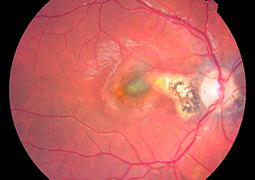Aim: To evaluate the epidemiological data, etiology and clinical characteristics, and to assess the efficacy and safety of intravitreal anti-vascular endothelial growth factor (anti-VEGF) therapy in the treatment of choroidal neovascular membrane (CNV) in children and adolescents. The results are compared with data from previously published studies and case reports.
Material and Methods: Retrospective analysis of medical records of patients treated for CNV at the Department of Pediatric Ophthalmology, University Hospital Brno, between January 2015 and April 2025. The cohort consisted of 12 patients, including 7 males and 5 females. All the cases involved unilateral disease; the right eye was affected in 7 patients and the left eye in 5. The mean age at onset was 11.8 years (range: 3–17 years). All underwent a comprehensive ophthalmological examination including optical coherence tomography (OCT); in 7 cases the diagnosis was confirmed by fluorescein angiography. The evaluated parameters included epidemiological data, clinical and morphological characteristics of CNV before and after anti-VEGF therapy. The etiology of CNV in our cohort was as follows: post-inflammatory/post-infectious in 6 cases, idiopathic in 3 cases, and one case each of myopic, post-traumatic, and neoplastic origin. The most common localization was subfoveal. All CNV lesions were classified as classic (type 2).
Results: All patients achieved either anatomical or functional improvement. No ocular or systemic adverse effects related to intravitreal anti-VEGF therapy were observed during the study period.
Conclusion: Early diagnosis and intervention with anti-VEGF therapy show favorable outcomes, including stabilization and remission of the disease. In our cohort, no adverse events or complications associated with intravitreal anti-VEGF administration were recorded. Continued research is essential in order to gain a further understanding of the pathogenesis of pediatric CNV and to optimize treatment strategies in children.

